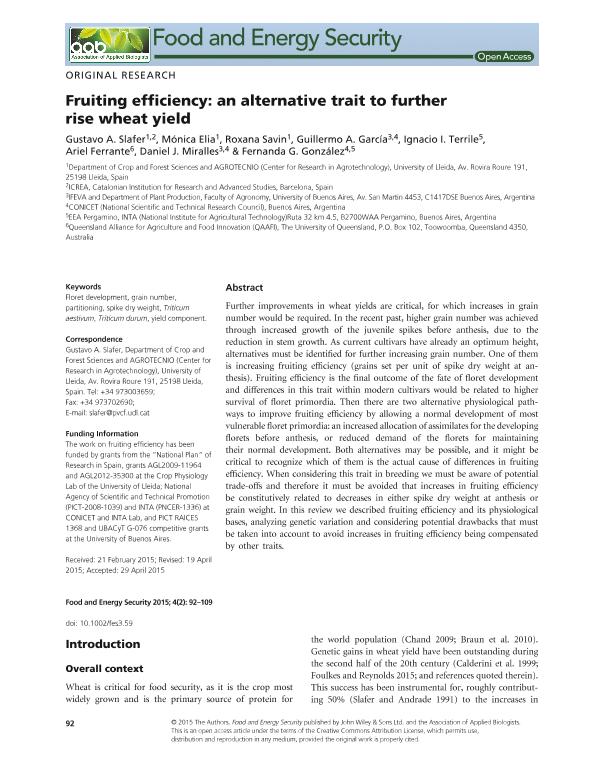Mostrar el registro sencillo del ítem
dc.contributor.author
Gustavo A. Slafer
dc.contributor.author
Elia, Mónica
dc.contributor.author
Savin, Roxana
dc.contributor.author
García, Guillermo Ariel

dc.contributor.author
Terrile, Ignacio Ismael
dc.contributor.author
Ferrante, Ariel
dc.contributor.author
Miralles, Daniel Julio

dc.contributor.author
González, Fernanda Gabriela

dc.date.available
2016-02-16T19:45:10Z
dc.date.issued
2015-05-28
dc.identifier.citation
Gustavo A. Slafer; Elia, Mónica; Savin, Roxana; García, Guillermo Ariel; Terrile, Ignacio Ismael; et al.; Fruiting efficiency: an alternative trait to further rise wheat yield; Wiley; Food and Energy Security; 4; 2; 28-5-2015; 92-109
dc.identifier.issn
2048-3694
dc.identifier.uri
http://hdl.handle.net/11336/4206
dc.description.abstract
Further improvements in wheat yields are critical, for which increases in grain number would be required. In the recent past, higher grain number was achieved through increased growth of the juvenile spikes before anthesis, due to the reduction in stem growth. As current cultivars have already an optimum height, alternatives must be identifi ed for further increasing grain number. One of them is increasing fruiting effi ciency (grains set per unit of spike dry weight at anthesis). Fruiting effi ciency is the fi nal outcome of the fate of fl oret development and differences in this trait within modern cultivars would be related to higher survival of fl oret primordia. Then there are two alternative physiological pathways to improve fruiting effi ciency by allowing a normal development of most vulnerable fl oret primordia: an increased allocation of assimilates for the developing fl orets before anthesis, or reduced demand of the fl orets for maintaining their normal development. Both alternatives may be possible, and it might be critical to recognize which of them is the actual cause of differences in fruiting effi ciency. When considering this trait in breeding we must be aware of potential trade- offs and therefore it must be avoided that increases in fruiting effi ciency be constitutively related to decreases in either spike dry weight at anthesis or grain weight. In this review we described fruiting effi ciency and its physiological bases, analyzing genetic variation and considering potential drawbacks that must be taken into account to avoid increases in fruiting effi ciency being compensated by other traits
dc.format
application/pdf
dc.language.iso
eng
dc.publisher
Wiley

dc.rights
info:eu-repo/semantics/openAccess
dc.rights.uri
https://creativecommons.org/licenses/by/2.5/ar/
dc.subject
Floret Development
dc.subject
Grain Number
dc.subject
Partitioning
dc.subject
Spike Dry Weight
dc.subject
Triticum Aestivum
dc.subject
Triticum Durum
dc.subject
Yield Component
dc.subject.classification
Agronomía, reproducción y protección de plantas

dc.subject.classification
Agricultura, Silvicultura y Pesca

dc.subject.classification
CIENCIAS AGRÍCOLAS

dc.title
Fruiting efficiency: an alternative trait to further rise wheat yield
dc.type
info:eu-repo/semantics/article
dc.type
info:ar-repo/semantics/artículo
dc.type
info:eu-repo/semantics/publishedVersion
dc.date.updated
2016-03-30 10:35:44.97925-03
dc.journal.volume
4
dc.journal.number
2
dc.journal.pagination
92-109
dc.journal.pais
Estados Unidos

dc.journal.ciudad
Hoboken
dc.description.fil
Fil: Gustavo A. Slafer. AGROTECNIO; España. Universidad de Lleida. Departamento de Producción Vegetal y Ciencia Forestal; España. Institució Catalana de Recerca i Estudis Avançats; España
dc.description.fil
Fil: Elia, Mónica. Universidad de Lleida. Departamento de Producción Vegetal y Ciencia Forestal; España. AGROTECNIO; España
dc.description.fil
Fil: Savin, Roxana. Universidad de Lleida. Departamento de Producción Vegetal y Ciencia Forestal; España. AGROTECNIO; España
dc.description.fil
Fil: García, Guillermo Ariel. Consejo Nacional de Investigaciones Científicas y Técnicas. Oficina de Coordinación Administrativa Parque Centenario. Instituto de Investigaciones Fisiológicas y Ecológicas Vinculadas a la Agricultura; Argentina. Universidad de Buenos Aires. Facultad de Agronomía. Departamento de Producción Vegetal; Argentina
dc.description.fil
Fil: Terrile, Ignacio Ismael. Instituto Nacional de Tecnología Agropecuaria. Centro Regional Buenos Aires Norte. Estación Experimental Agropecuaria Pergamino; Argentina
dc.description.fil
Fil: Ferrante, Ariel. The University of Queensland. Queensland Alliance for Agriculture and Food Innovation; Australia
dc.description.fil
Fil: Miralles, Daniel Julio. Consejo Nacional de Investigaciones Científicas y Técnicas. Oficina de Coordinación Administrativa Parque Centenario. Instituto de Investigaciones Fisiológicas y Ecológicas Vinculadas a la Agricultura; Argentina. Universidad de Buenos Aires. Facultad de Agronomía. Departamento de Producción Vegetal; Argentina
dc.description.fil
Fil: González, Fernanda Gabriela. Instituto Nacional de Tecnología Agropecuaria. Centro Regional Buenos Aires Norte. Estación Experimental Agropecuaria Pergamino; Argentina. Consejo Nacional de Investigaciones Científicas y Técnicas; Argentina
dc.journal.title
Food and Energy Security
dc.relation.alternativeid
info:eu-repo/semantics/altIdentifier/doi/http://dx.doi.org/10.1002/fes3.59
dc.relation.alternativeid
info:eu-repo/semantics/altIdentifier/url/http://onlinelibrary.wiley.com/doi/10.1002/fes3.59/abstract
dc.relation.alternativeid
info:eu-repo/semantics/altIdentifier/issn/2048-3694
Archivos asociados
